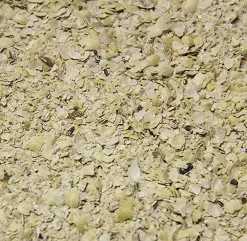Description
Corn gluten feed is the by-product of the wet-milling of maize grain for starch (or ethanol) production (Hoffman et al., 2010). Corn gluten feed consists mainly of maize bran and maize steep liquor (liquid separated after steeping) but may also contain distillers solubles, germ meal, cracked maize screenings, as well as minor quantities of end-products from other microbial fermentations (Stock et al., 1999). The chemical composition of corn gluten feed varies hugely, as it depends on the milling process and on the relative proportions of bran, steep liquor and other components. Particularly, the energy and protein content of corn gluten feed are positively correlated to the proportion of steep liquor in the blend (Stock et al., 1999).
The wet-milling process of maize is described in the figure above. The process yields 5 main products: maize starch, maize germ oil meal, corn gluten meal, corn gluten feed and maize steep liquor. After cleaning and removal of foreign material, the maize grain is usually steeped in water with sulfur dioxide (SO2) for 24-40 hours at a temperature of 48-52°C. The role of sulfur dioxide is to weaken the glutelin matrix by breaking inter- and intramolecular disulfide bonds. Steeping at 45-55°C favours the development of lactic acid bacteria that produce lactic acid, lowering the pH of the medium and thereby restricting growth of most other organisms. At the end of steeping phase, the maize kernels contain about about 45% water, have released about 6.0-6.5% of their dry substance as solubles into the steepwater and have become sufficiently soft to be pulled apart easily with the fingers (BeMiller et al., 2009). After steeping, the maize kernels are coarsely ground so that the germs are separated from the endosperm and used for oil extraction which yields maize germ oil meal. The remaining steeping water is condensed into a steep liquor. The endosperm undergoes further screenings that separate the fibre from gluten (protein fraction) and starch slurry. Fibre (bran) can be mixed with steep liquor and maize germ oil meal to create corn gluten feed (ISI, 2008; RFA, 2011). The fibre-free endosperm is centrifugated in order to separate the starch fraction and the gluten, which have different densities, resulting in almost pure starch (99% starch), and corn gluten meal (CRA, 2006).
Corn gluten feed is a feed ingredient mostly used in cattle diets as a source of energy and protein. Its economic value depends upon the relative price of whole grain and protein feeds. In the United States, it is usually considered as a source of protein (Ash, 1992). However, in the late 1980s, corn gluten feed was one of the several duty-free Non Grain Feed Ingredients that the European feed industry imported massively from the USA as a source of energy, to substitute for EU cereal grains that were very expensive at the time. Corn gluten feed imports declined after the Common Agricultural Policy (CAP) reforms reduced EU grain prices (Ash, 1992; Hasha, 2002).
Corn gluten feed is usually sold after drying, but maize processors may save on drying cost by selling wet corn gluten feed.
Note: it is important to note that corn gluten feed should not be mistaken for corn gluten meal, which contains about 65% crude protein instead of 22% and is nutritionally completely different. The name similarity of these products is an occasional source of confusion, particularly in papers written by non-native English speakers.
Dried corn gluten feed is traded worldwide. Corn gluten meal and corn gluten feed production is relatively constant since ethanol is now mainly produced in dry mills (RFA, 2008). The consumption of corn gluten meal and corn gluten feed together was about 14.9 million t from October 2010 to September 2011. The main consumers of both products are the USA (5.6 million t), EU (3 million t), South Korea (1 million t), Japan (0.94 million t) and other Asian countries (1.6 million t). The USA supply 60% (2.1 of 3.5 million tons) of the corn gluten feed traded worldwide. The main importers for 2010-2011 were the EU, South Korea, Turkey, China, Japan, Israel, Egypt and Indonesia (Oil World, 2011).
Unlike dried corn gluten feed, wet corn gluten feed spoils easily and is usually distributed nearby maize processing plants.
Related products
Animal feeds
Animal feeds
Animal feeds
Animal feeds





